This is just a quick run-through of my thoughts on some of the big names and a few others for this week.
Rory McIlroy
It seems like there’s some trepidation over installing McIlroy as the favorite this week, despite him playing clearly the best golf of anyone in the world for the past year. I’ve seen some insisting that Bubba is the favorite – two Green Jackets in three years and all – while others think Jordan Spieth’s success here last year and hot run over the past month plus means he’s the favorite. Sport fans struggle with perspective, especially around the biggest stars, and in the case of McIlroy and the Masters, perspective is critical.
It’s true that his PGA Tour play this season has been spotty (MC-9th-11th in three events in Florida), but his missed cut came on a 3 wood heavy course that he’s generally struggled at over his career. Rory relies so much on the advantage of blowing his driver 20 yards past the field that when he’s forced to ease up off the tee he’s a different golfer. Besides that MC, Rory has finished 2nd at a strong European Tour event, won another strong European Tour event, and then finished around 10th at two strong PGA Tour events. The quality of his golf in 2015 has been the same as in 2014.
As for his Masters history, it’s mostly mediocre for a player of his caliber, but this is a course which clearly favors guys who can bomb it around and feast on par 5s. However, during his career at Augusta National McIlroy has suffered from an inability to score on the par 5s (4.76 average compared to 4.70 for the field) and a tendency towards big numbers (3.5% double/triple bogey rate compared to 2.5% for the field). Basically, if you think McIlroy will struggle here you believe that he’s unable to score on the par 5s here (with that huge, high draw I think that’s unlikely) and uniquely snake-bitten in terms of posting big numbers (rather than the victim of bad luck).
Adam Scott
Perhaps because of his sparse schedule, Adam Scott hasn’t gotten enough credit for the three year run he put together between 2012 and 2014: 48 official Tour events, 47 made cuts, 21 top 10s, and three victories including the 2013 Masters. Perhaps some criticism of his lack of wins is warranted, but he plays at events with mostly very strong fields and he’s taken a very solid 6% of his events. Until McIlroy hit the gas last summer, there was definitely a debate over whether he or Scott was the best in the world. Obviously not now, but in my estimation Adam Scott enters this year’s Masters Tournament as the solid second best in the field.
Scott has great course history here, which is to be expected with his distance and ability to hit his irons so well, and he’s entering with his tee to green game looking really sharp. His performance on the Florida swing was consistently elite tee to green (+1.5, +1.7, +1.7 strokes gained/round against strong fields), but he struggled while trying out the short putter and that absolutely torpedoed his overall results in Tampa and Orlando. He’s back to the anchored long putter this week and if he can just be his normal mediocre self on the greens, he’ll be in line for a high finish.
Phil Mickelson
Phil has owned Augusta National to the tune of three wins and a yearly tradition of top finishes, but the results the past couple years just haven’t been there. What’s illuminating is that when you plot Phil’s average driving distance alongside his Masters performances, there’s a pretty obvious trend. Prior to 2012, his worst finish in driving distance was 35th. During this period his combination of power off the tee, great irons/wedges, and a really strong short game made him one of the best in the world (and made up for the fact he had no clue where his tee shots were going). In 2012 he slipped to 53rd on Tour in driving distance, then 93rd and 70th the next two years.

Along with that distance decline, his Masters results in 2013 and 2014 were both his worst since missing the cut in 1997. Phil went from scoring an average of 4.36 on the par 5s between 2008-12 to 4.70 in 2013-14. Now, this year it looks like he’s got some of his power back (driving distance and club head speed are both up), so there’s definitely some hope he’ll return to former levels of success here.
Jordan Spieth
Spieth’s run over the past two months has been great to watch and he’s fully recovered from his struggles off the tee in the second half of last season. What is interesting is how he’s changed his game even from his rookie year in 2013. Spieth was one of the most accurate guys on Tour that season, with above-average distance. Last year, his driving numbers weren’t nearly as strong and he spent the last half of the season spraying his drives off the tee, making a bid for the Tour Sauce Hall of Fame. This year he’s gotten significantly longer (~5 yards), and he’s kept his tee shots in play like in his rookie season. That’s driven his long game to elite levels.
He’s riding a bit of a lucky putter right now so it’s important to view his recent play in a slightly skeptical light. But he is one of the top 10-15 putters on Tour, so it’s not like he’s going to fall off much.
Keegan Bradley
I haven’t heard Keegan’s name mentioned at all this week, which shows the power prior play at Augusta National has over people. Keegan’s three starts here have been mediocre as a whole, especially for a guy who’s been around the 20th best in the world over that time, but he absolutely fits the mold of a guy who should shine here. He launches the ball off the tee with a solid draw, he doesn’t struggle on bentgrass greens, and he has putted better than average on similar lightning quick greens at Firestone, Houston, and Muirfield Village.
Chris Kirk
Kirk played well last year in his first Masters trip and stands out as a pretty attractive long-shot pick. His game has been messy this year, especially when contrasted with his successes at the end of last season. The common theme so far has been just really poor putting. Kirk’s established himself as a very strong putter over the last few years, but he’s not making anything so far in 2015. Kirk’s been especially poor at making long putts (2% of his 25+ footers have gone in), despite a recent history where he’s one of the best on Tour at making putts from distance over 2011-14. I’ve written about how long putting seems to be especially random, driving putting results up or down without reflecting genuine improvements or declines in putting ability. Based on that, I expect Kirk to start producing better results on the greens and overall.
Weather
The forecast looks wet all weekend which I’ve seen taken as evidence that McIlroy, in particular, will be in good shape considering his wet weather record (his WGC-Bridgestone and PGA Championship wins last year were both on wet courses). I took a look at how players with high or low ball flights played in a handful of clearly wet rounds (WGC-Bridgestone 4th round & PGA Championship rounds 2-4). Players who bring it in high onto damp greens should be able to stick it closer than those who bring it in low.
It turns out that just looking at those four rounds (~250 individual rounds), that hypothesis was borne out in the data. I specifically measured Strokes Gained on Iron shots (par 4/5 approach shots & par 3 tee shots) and compared performance in these specific rounds to all the data I have more a player since last season. This controls for talent hitting irons. The correlation with the PGA Tour’s Trackman derived Apex Height stat wasn’t strong, but the coefficients suggest a player with an extremely high ball-flight – J.B. Holmes, Keegan Bradley – could gain about a 0.15 or more strokes from their normal level of play just on their iron shots if the course plays wet this week.

This is definitely a subject worth a more formal investigation, but the data points to high ball-flight players being advantaged to a small degree in wet weather.



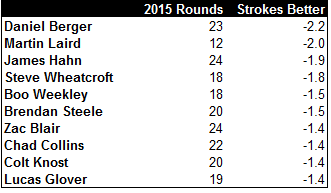
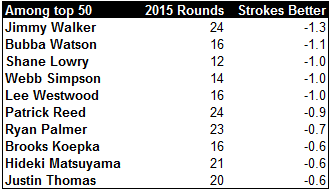
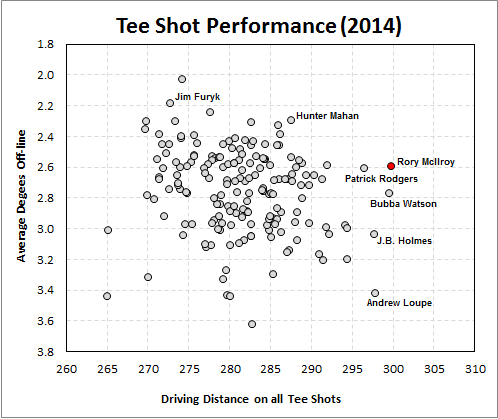
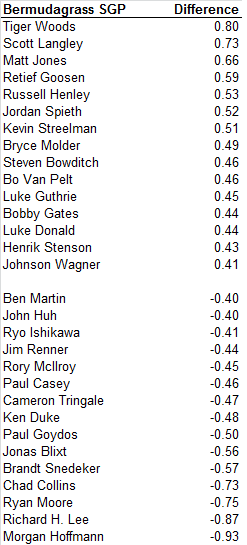
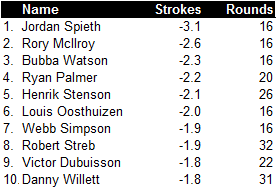
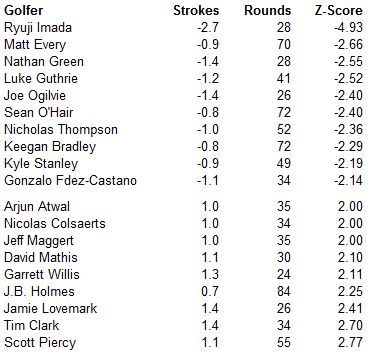
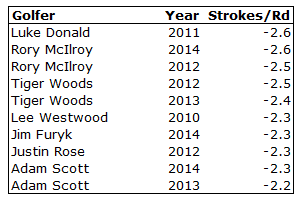
Recent Comments